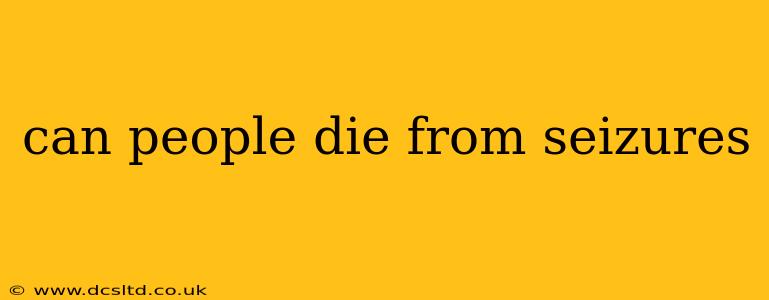Can People Die From Seizures? Understanding Seizure-Related Mortality
Sudden unexpected death in epilepsy (SUDEP) is a tragic reality, highlighting the potential for seizures to be life-threatening. While not all seizures are fatal, it's crucial to understand the risks and what factors contribute to this possibility. This article explores the connection between seizures and death, addressing common questions and concerns.
What is SUDEP?
Sudden unexpected death in epilepsy (SUDEP) is the sudden, unexpected, non-traumatic, and unwitnessed death in individuals with epilepsy who have no other apparent cause of death. It's a significant concern for people with epilepsy, their families, and healthcare providers. While the exact cause of SUDEP remains a mystery, ongoing research points to several contributing factors.
What causes SUDEP?
The exact mechanisms leading to SUDEP aren't fully understood, but several theories exist:
- Cardiac arrhythmias: Prolonged seizures can disrupt the heart's rhythm, leading to fatal cardiac arrest.
- Respiratory failure: Seizures can suppress breathing, leading to a lack of oxygen reaching the brain and other vital organs.
- Brain stem dysfunction: The brainstem, responsible for controlling vital functions like breathing and heart rate, can be affected during prolonged or severe seizures, potentially leading to respiratory or cardiac arrest.
What are the risk factors for SUDEP?
Several factors increase the risk of SUDEP:
- Frequency of seizures: More frequent and longer seizures significantly increase the risk.
- Types of seizures: Tonic-clonic (grand mal) seizures carry a higher risk than other seizure types.
- Poor seizure control: Individuals whose seizures aren't well-managed with medication are at greater risk.
- Sleep-related seizures: Seizures occurring during sleep are associated with a higher risk of SUDEP.
- Other health conditions: Co-existing health issues can increase the risk.
How can SUDEP be prevented?
While there's no guaranteed way to prevent SUDEP, several strategies can significantly reduce the risk:
- Effective seizure management: Working closely with a neurologist to optimize medication and treatment plans is critical.
- Regular medical checkups: Consistent monitoring and assessments by a healthcare professional help identify potential problems early on.
- Lifestyle adjustments: Getting enough sleep, avoiding alcohol and drugs, and maintaining a healthy lifestyle can improve overall health and potentially reduce the risk.
Is it possible to die from a single seizure?
While rare, it's possible. A very severe, prolonged seizure could lead to cardiac arrest or respiratory failure, even in someone without a history of epilepsy. This is less common than SUDEP, which generally occurs in individuals with a history of epilepsy and uncontrolled seizures.
Can someone die from a seizure in their sleep?
Yes, sleep-related seizures pose a significant risk for SUDEP. The lack of awareness during sleep means that breathing issues or cardiac problems related to the seizure may go undetected until it’s too late.
What are the warning signs of a life-threatening seizure?
Warning signs can vary, but prolonged seizures (lasting longer than 5 minutes), difficulty breathing, cyanosis (bluish discoloration of the skin), and loss of consciousness are all serious indicators that require immediate medical attention. If you witness a seizure lasting this long, call emergency services immediately.
This information is for educational purposes only and does not constitute medical advice. If you have concerns about seizures or epilepsy, please consult with a qualified healthcare professional. They can provide personalized advice based on your individual circumstances and medical history.
